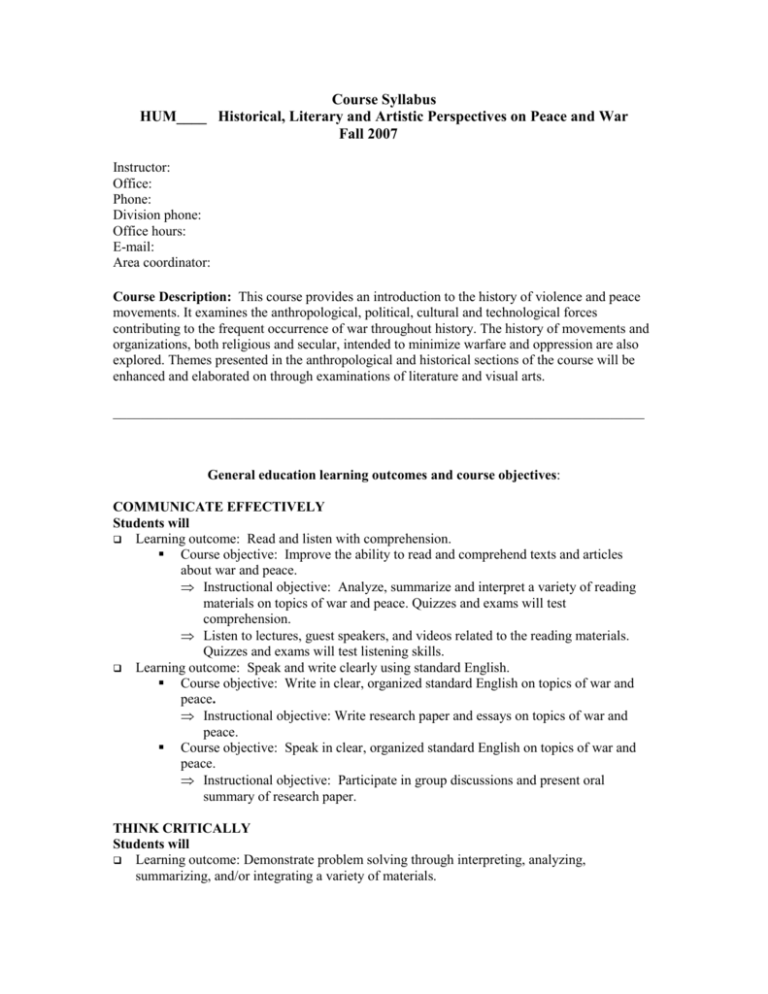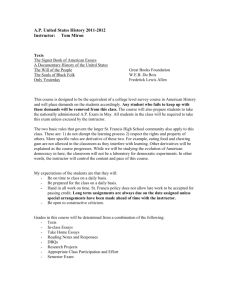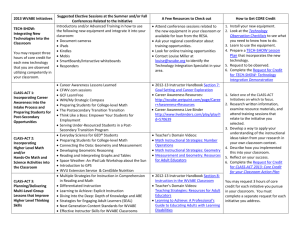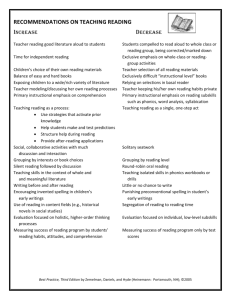Course Syllabus
advertisement

Course Syllabus HUM____ Historical, Literary and Artistic Perspectives on Peace and War Fall 2007 Instructor: Office: Phone: Division phone: Office hours: E-mail: Area coordinator: Course Description: This course provides an introduction to the history of violence and peace movements. It examines the anthropological, political, cultural and technological forces contributing to the frequent occurrence of war throughout history. The history of movements and organizations, both religious and secular, intended to minimize warfare and oppression are also explored. Themes presented in the anthropological and historical sections of the course will be enhanced and elaborated on through examinations of literature and visual arts. _____________________________________________________________________________ General education learning outcomes and course objectives: COMMUNICATE EFFECTIVELY Students will Learning outcome: Read and listen with comprehension. Course objective: Improve the ability to read and comprehend texts and articles about war and peace. Instructional objective: Analyze, summarize and interpret a variety of reading materials on topics of war and peace. Quizzes and exams will test comprehension. Listen to lectures, guest speakers, and videos related to the reading materials. Quizzes and exams will test listening skills. Learning outcome: Speak and write clearly using standard English. Course objective: Write in clear, organized standard English on topics of war and peace. Instructional objective: Write research paper and essays on topics of war and peace. Course objective: Speak in clear, organized standard English on topics of war and peace. Instructional objective: Participate in group discussions and present oral summary of research paper. THINK CRITICALLY Students will Learning outcome: Demonstrate problem solving through interpreting, analyzing, summarizing, and/or integrating a variety of materials. Course objective: Analyze the power relations that lead to group violence in a society. Instructional objective: Read essays, write reflective papers, and/or hold group discussions about causes of group violence. Course objective: Analyze non-violent resistance of the past. Instructional objective: Read essays, write reflective papers, and/or hold group discussions about non-violent resistance. Course objective: Articulate an understanding of art and literature as reflections of the culture of a particular time and place. Instructional objective: Through papers and class discussions analyze and discuss works of art and literature with particular attention to making connections between these works and their social and historical contexts. LEARN INDEPENDENTLY Students will Learning outcome: Apply learning in academic, personal, and public situations. Course objective: Examine one’s attitudes, values, and assumptions about war and peace and consider their consequences. Instructional objective: Write reflective papers and hold group discussions examining attitudes, values, and assumptions. Learning outcome: Make choices based upon awareness of ethics and differing perspectives/ideas. Course objective: Reassess fundamental assumptions regarding human motivations, values, and goals. Instructional objective: Take a new look at human nature and violence through lectures and readings, reaction papers and class discussions. EXAMINE RELATIONSHIPS IN DIVERSE AND COMPLEX ENVIRONMENTS Students will Learning outcome: Recognize the relationship of the individual to human heritage and culture. Course objective: Analyze non-violent resistance of the past. Instructional objective: Listen to lectures, read essays, hold discussions, and/or write papers about peace efforts in the past. Course objective: Compare and contrast ideas and themes related to war and peace across a range of contexts, cultures, and areas of knowledge. Instructional objective: Compare/contrast ideas and themes through papers and class discussions. Textbooks and Materials: 1. Approaches to Peace: A Reader in Peace Studies, David Barash (editor). Oxford University Press, 2000. 2. The Penguin Atlas of War and Peace, by Dan Smith, Penguin Books, 2003 3. Readings as assigned 4. Access to a computer, as class readings and other information will be posted on the Angel website. To access the Angel site: go into www.kyvu.org/home.htm. Your username is your first initial + your last name + the last four digits of your social security number. Your password is the last four digits of your social security number. You can send messages to other students in the class or to the professor, via “In Touch.” Class information and assignments will be posted under “Lessons.” Course Requirements: Exam #1 100 points Exam #2 Class work Reflective writings Research Paper 100 100 100 100 Class work may include case studies, collaborative group reports, discussions, quizzes, and short in-class writings. Reflective writings may take the form of a journal in which students reflect on lectures and discussions from class. For the Research Paper each student will examine a particular war in light of the themes presented in the course. Both exams and the Research Paper must be completed in order to pass the class. There will be opportunities to earn up to 15 extra points. A=450-500; B=400-449; C=350-399; D=300-349; E=below 300 Course Policies: 1. ATTENDANCE: Attendance will be taken every class period. Students are expected to attend every class, to be on time, and to stay the entire class period. If you chronically miss part of the period, you will be penalized. If an absence is unexcused, the student is not allowed to make up missed work. The combination of excused and unexcused absences cannot exceed onefifth of the class contact hours. If a student misses more than one-fifth of the class, the instructor will suggest that the student to withdraw to avoid a failing grade. If there is a special circumstance, the student must provide documentation explaining the absences, and the student must be in touch with the instructor throughout the semester. 2. WITHDRAWAL: Students may withdraw before midterm without the instructor's permission; after midterm, the instructor's permission is required and will be given if, in the instructor's judgment, the situation warrants withdrawal. In that case, a student can reach the instructor during office hours or before/after class to sign the withdrawal slip. Remember, it is the student's responsibility to officially withdraw. Students who stop coming to class but do not officially withdraw will receive a failing grade for the course. 3. CLASSROOM ETIQUETTE: Please keep your cell phones turned off. If you must leave early, please inform me at the beginning of the class. 4. Plagiarism and Cheating: These academic offenses will be severely punished. For definitions of these academic offenses and the punishments for students charged with them see Student Rights and Responsibilities, which is available on the Web at http://www.kctcs.edu/student/code.htm 5. REASONABLE ACCOMMODATION: If you have a special need that may require an accommodation or assistance, please inform the instructor as soon as possible and no later than the second class meeting. Course Outline I. Weeks 1, 2 Anthropological Perspectives on Competition and Cooperation. A. The Anthropological Perspective 1. The Science of Studying Socio-Cultural Phenomena 2. Adaptation: Socio-Biological and Socio-Cultural Behavior B. Human Behavior 1. Competition as an Evolutionary Adaptation 2. Cooperation as an Evolutionary Adaptation 3. Film: Jane Goodall's Wild Chimpanzees C. Understanding War from a Socio-Cultural Perspective 1. Environmental Circumscription 2. Social Circumscription 3. Creating Social Distance D. Understanding Peace from a Socio-Cultural Perspective II. III. Weeks 3, 4, 5 History of Violence A. Types of War 1. “Just” vs. “Unjust” 2. Conquest 3. Liberation 4. Civil B. Generations of Modern Warfare 1. The Age of Absolutism 2. The Age of Democracy and Industrialization 3. Asymmetrical Warfare Weeks 6, 7, 8 History of Peace Movements A. Types of Anti-war Movements 1. Religious a. The Christian Tradition b. The Eastern Tradition 2. Secular a. Internationalists b. Trans-nationalists B. Major Individual Activists 1. Gandhi 2. Dr. Martin Luther King, Jr. 3. Dorothy Day IV. V. Weeks 9, 10, 11, 12 Literature of War and Peace A. Glory and Honor: The Case for War in Literature 1. Ancient and Medieval Literature 2. Modern Literature B. World War I: The Change in Attitude 1. Poets at the Beginning of the War 2. The Use of Propaganda and Reaction to It 3. The Poet as Dissenter. C. War as Oppression: The Opposition to War in Literature 1. War as Absurd. 2. War as Madness. Weeks 13, 14, 15 Artistic Expression of Violence and Peace A. Historical Context: Commemoration of Experience. B. Social Context: Raising of Social Consciousness and Protest of Injustice. This schedule is subject to change. Readings will be assigned on a weekly basis. ________________________________________________________________________ Reference List Ackerman, Peter, and Jack Duvall. A Force More Powerful: A Century of Nonviolent Conflict. New York: St. Martin’s Press, 2000. Brock, Peter. The Quaker Peace Testimony, 1660-1914. York, England: William Session Ltd., 1991. Bruckner, D.J. Art Against War: 400 Years of Protest in Art. New York: Abbeville Press, 1984. Chatfield, Charles, ed. Peace Movements in America. New York: Schocken Books, 1973. Dellinger, David. Revolutionary Nonviolence: Essays. Garden City, N.Y.: Anchor Books, Doubleday & Company, 1971. Douglass, James W. The Non-Violent Cross: The Theology of Revolution and Peace. York: The Macmillan Company, 1969. New Evan, W. M. War and Peace in an Age of Terrorism: A Reader. New York: Allyn and Bacon, 2005 Gara, Larry, and Lenna Mae Gara. A Few Small Candles: War Resisters of World War II Tell Their Stories. Kent, Ohio: The Kent State University Press, 1999. Hallock, Daniel. Hell, Healing, and Resistance: Veterans Speak. Farmington, Pa.: The Plough Publishing House of the Bruderhof Foundation, 1998. Hammes, Colonel Thomas X. The Sling and the Stone: On War in the 21st Century. St. Paul, MN: Zenith Press, 2004. Harris, Ian M. Peace Education. Jefferson, N.C.: McFarland and Co., 1998. Isaacs, Arnold R. Vietnam Shadows: The War, Its Ghosts, and Its Legacy. Baltimore: Johns Hopkins University Press, 1997 Keegan, John. A History of Warfare. New York: Vintage, 1993. King, Dr. Martin Luther, Jr., A Testament of Hope : The Essential Writings and Speeches of Martin Luther King, Jr. San Francisco: Harpers, 1990. Krieger, David, and Frank Kelly. Waging Peace II: Vision and Hope for the Twenty-first Century, An Anthology of Essays. Chicago, Ill.: The Noble Press, 1992. Lantieri, Linda, and Janet Patti. Waging Peace in Our Schools. Boston: Beacon Press, 1996. Lynd, Staughton, and Alice Lynd. Nonviolence in America: A Documentary History. Maryknoll, N.Y.: Orbis Books, 1995. McCarthy, Colman. I’d Rather Teach Peace. Maryknoll, N.Y.: Orbis Books, 2002. McCarthy, Colman, ed. Strength Through Peace: The Ideas and People of Nonviolence. Washington, D.C.: Center for Teaching Peace, 1995 Merton, Thomas. The Nonviolent Alternative. New York: Farrar, Straus & Giroux, 1980. Merton, Thomas, ed. Gandhi on Nonviolence: A Selection from the Writings of Mahatma Gandhi. New York: New Directions Publishing, 1964. Nagler, Michael N. The Search for a Nonviolent Future. Berkeley, Calif.: Berkeley Hills Books, 2001. Preston, Richard. Men in Arms: A History of Warfare and Its Interrelationships With Western Society. Austin, TX: Holt, Rinehart and Winston, 1991. Seeley, Robert. The Handbook of Nonviolence: An Encyclopedia of Pacifism. Westport, Conn.: Lawrence Hill & Co., 1986. True, Michael. An Energy Field More Intense Than War: The Nonviolent Tradition and American Literature. Syracuse, N.Y.: Syracuse University Press, 1995. Vanderhaar, Gerald A. Active Nonviolence: A Way of Personal Peace. Mystic, Conn.: TwentyThird Publications, 1990. Weeks, Dudley. The Eight Essential Steps to Conflict Resolution. New York: Tarcher, 1994. Zinn, Howard. Artists in Times of War and Other Essays. New York: Seven Stories Press, 2003. Zinn, Howard. Declarations of Independence: Cross-examining American Ideology. New York: HarperCollins Publishers, 1990.






